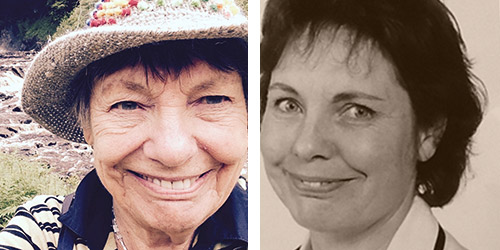CSP’s former chair and octogenarian Joyce Williams passes on tales of the not-so-good old days

Grandma Williams (GM) now and in her younger (JW) days.
Once upon a time in the early days of physiotherapy.....
Patients, meaning old ladies, with 'broken hips' were put on traction for 10 weeks, maybe longer. The only hope was to see if it would heal. No hip replacements then!
There they lay, pretty immobile, pressure sores developing, inevitably bladder infections making matters worse, and finally broncho-pneumonia. We did what we could, with whole ward bed activity classes, breathing exercises and specific treatment. If they survived, and the rate was low, we had the job of getting them on their feet.
Can you guess what happened? Maybe not. Yes, the usual blood pressure problem, weakness, dizziness and so on. But they had one peculiar problem. They all keeled over backwards! Zimmer in the air and flat on their backs if you weren't quick.
It was some years before we understood. (We were still in the post war orthopaedic injury era and not yet into the current level of neurology.) It was a postural reflex problem. After 10 weeks flat on your back, with your rusty old neck on a pillow at 70 degrees to your spine, your head body reflexes realign. Those patients got out of bed looking at the ground, but the second they lifted their heads upright, over they went. Once understood of course, it was preventable and solvable.
Looking back, we also had a strange problem with patients who had had a stroke. They developed severe knee flexion contractures. Can you work that out?
Medical worries led to most patients being nursed in bed for weeks post-stroke. There they lay, often incontinent and rarely moved, except when we visited. Pressure sores again, but in these patients particularly nasty heel sores. Again, we didn’t understand the neurology at that time, but the start of a heel sore produced a vicious cycle.
It set up a flexor withdrawal reflex pattern, which was I suspect aided by the lying down posture and never standing. As well-trained physotherapists, taught in the post-polio era, we regarded potential knee contractures with horror. Set to work to stretch them daily! Hard... the result, even worse contractures. So when they were allowed to get up and we could begin walking they had to have a full length metal leg brace. A spring for the inevitable drop foot, plus a laced leather thigh cuff and a ratchet for increasing the stretch on the contracted knee!
And then there were slipped discs. These popped out all the time, according to patients and the media. It was all the fault of flexion of course. If you never bent, they wouldn't pop. The obvious answer was a flat back on a flat bed, and rigid chairs. Even better the discs needed inter-vertebral space so that they could pop back in. So the medical solution to that was spinal traction … in bed for three or six weeks with weights. Then, to protect the now weakened spine, it was deemed wise to wear a corset, one with bones, or even, a complete plaster jacket. It was a brave physio who suggested that a soft bed and mobility might be a better solution. And of course, we were still operating under doctor's orders.
It was not until Health Circular 77/33 – the one that gave our profession autonomy – released us from that were we able to move on easily to spinal mobilisation.
Hindsight is a wonderful thing, and very cringe making!

Visit the Grandma Williams Wordpress blog to catch up on other posts from Joyce. You can also follow her on Twitter: @JoyceWilliams_
Number of subscribers: 0




































